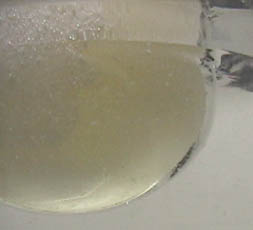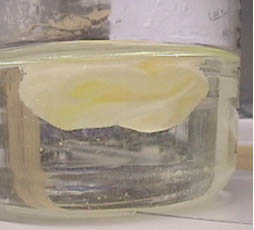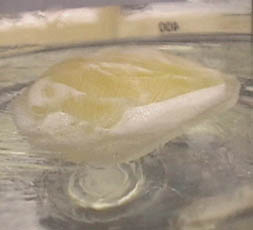Osmotic Pressure Example
An Egg in Karo Syrup
An excellent example of a semipermeable membrane is that inside the shell of an egg. After shell removal is accomplished with acetic acid, the membrane around the egg can be used to demonstrate osmosis. Karo syrup is essentially pure sugar, with very little water in it, so its osmotic pressure is very low. Placed in the syrup for 36 hours, the egg in the image below had most of the liquid of the eggwhite removed. What remained was essentially the membrane plus the yoke of the egg.

|

|
The egg's membrane is permeable to water molecules but not to the sugar molecules. Within an hour after the egg was placed in the syrup as shown at left, there is a visible layer around the egg. This is interpreted as a layer into which water molecules from inside the egg have penetrated, reducing the concentration of the syrup. Changing the concentration of the sugar solution changes its index of refraction. At certain angles, this change in index of refraction leads to total internal reflection, creating the mirror-like appearance of part of the layer.
|
The rapid migration of the water out of the egg into the syrup continues until the egg takes the appearance at right. Little evidence of the egg white remains, since it is mostly water. The water molecules can move across the membrane into the syrup, but the syrup molecules are too large to get through the membrane. Thermal energy keeps molecules moving rapidly. At room temperature, water molecules are moving at speeds of several hundred meters/sec and bombard the membrane ceaselessly. The process of diffusion leads to a net transfer of water molecules out of the egg and into the syrup until the concentrations are equal on the two sides. With this much syrup, that never happens, so the egg loses nearly all its water. |

|
| Rate of diffusion | Osmosis | Thermal energy |
Kinetic theory concepts
Applications of kinetic theory
Fluid concepts
| HyperPhysics***** Thermodynamics | R Nave |